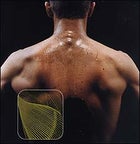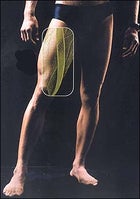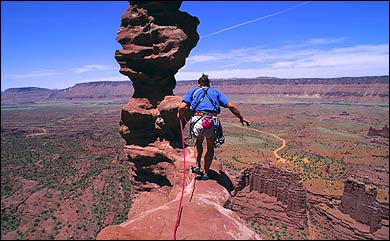It’s time to take your enthusiasm up a notch. We’ve sussed out more than 60 of the country’s best adventure camps—cool schools to supercharge your surfing, skiing, cycling, and other sports. PLUS: Camps for singles; wisdom from veteran guides; and where to learn gourmet backcountry cooking, new languages, space walking, and more.
Research and Reporting by Micheal Behar, Jason Daley, Lolly Merrel, and Pieter VanNoordennen
Hot Flex
Kayaking, Running, & Swimming
muscles, exercises, strength
 Latissimus Dorsi: the runner’s turbo booster
Latissimus Dorsi: the runner’s turbo boostermuscles, exercises, strength
 Sartorius: where a swimmer’s power kick begins
Sartorius: where a swimmer’s power kick begins
KAYAKING
As you paddle, your back and shoulders do most of the work. But Nancy Cummings, of the USA Triathlon National Training Center, in Clermont, Florida, says kayakers also need strong serratus anterior muscles—the ones just below the armpit, at the rib cage. These muscles are pivotal in aiding streamlined strokes: By allowing your shoulder to rotate upward, they give additional strength to the upper back and shoulder areas on every stroke. “You have to develop those muscles to reach full power,” says Cummings.
The Exercise: Vertical Push-Ups
Stand facing a wall with your feet shoulder width apart and about three feet from the wall. Put your palms flat on the wall at head height so you’re positioned to do push-ups against the wall. Do four sets of 20 reps.
RUNNING
Good legs and lungs made Tina Turner’s career, but they’ll take a runner only so far. Strong latissimus dorsi (“lats” for short), the large wedgelike muscles on both sides of your back, are what you need for speed. “The key is integration between the lats and the glutes,” says Cosgrove. “Both muscles are designed to work together in a perfect line. Weak lats mean weak glutes, which mean reduced propulsion.” His proof: “A college football player I worked with shaved two-tenths of a second off his 40-meter-sprint time just by strengthening his lats.”
The Exercise: One-Arm Pullovers
Lie with your back on a Swiss ball and your feet flat on the floor, shoulder width apart. Hold a ten-pound dumbbell in one hand over your chest. Straighten your arm, and lower the weight behind your head, stopping when your upper arm is parallel to the ground. Slowly return the weight to the starting position. Do two sets of ten reps on each side. If it seems too easy, grab a heavier dumbbell.
SWIMMING
Whether you’re swimming laps or fighting for position in a triathlon, virtually every muscle in your body is helping you move through the water. But one of the muscles that gets little work is the sartorius, which starts on the outside of the hip and stretches across your thigh to the inside of your knee. It’s the rotator muscle that provides power during breaststroke and freestyle kicking. “A fit sartorius helps all the external rotator muscles of the hip stay strong,” says Baltimore-based trainer Stephen Holt.
The Exercise: Cable Leg Crossovers
Attach one end of a rubber exercise band to your left foot and one end to a stable piece of furniture. Stand so the tube is at a 45-degree angle behind you. (Picture yourself in the center of a clock dial, facing the 12; the band should stretch toward the 8.) Keeping most of your weight on your right leg, step back with your left foot toward the furniture. Then kick your left foot toward two o’clock, rotating your hips and swinging it across your body at a 45-degree angle. Repeat. Do 15 reps, then switch legs.


